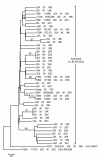Tularemia in Alaska, 1938 - 2010
- PMID: 22099502
- PMCID: PMC3231942
- DOI: 10.1186/1751-0147-53-61
Tularemia in Alaska, 1938 - 2010
Abstract
Tularemia is a serious, potentially life threatening zoonotic disease. The causative agent, Francisella tularensis, is ubiquitous in the Northern hemisphere, including Alaska, where it was first isolated from a rabbit tick (Haemophysalis leporis-palustris) in 1938. Since then, F. tularensis has been isolated from wildlife and humans throughout the state. Serologic surveys have found measurable antibodies with prevalence ranging from < 1% to 50% and 4% to 18% for selected populations of wildlife species and humans, respectively. We reviewed and summarized known literature on tularemia surveillance in Alaska and summarized the epidemiological information on human cases reported to public health officials. Additionally, available F. tularensis isolates from Alaska were analyzed using canonical SNPs and a multi-locus variable-number tandem repeats (VNTR) analysis (MLVA) system. The results show that both F. t. tularensis and F. t. holarctica are present in Alaska and that subtype A.I, the most virulent type, is responsible for most recently reported human clinical cases in the state.
Figures


References
Publication types
MeSH terms
Grants and funding
LinkOut - more resources
Full Text Sources

